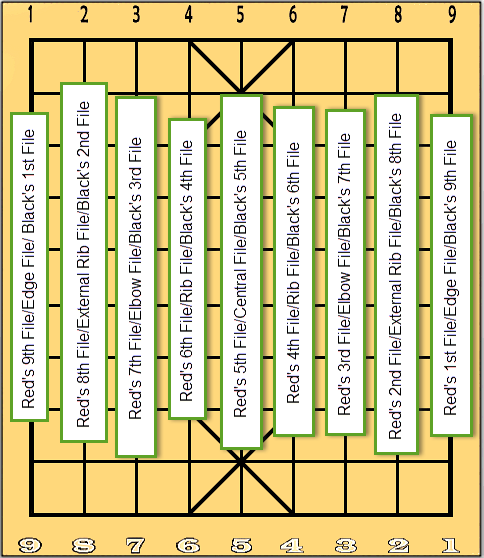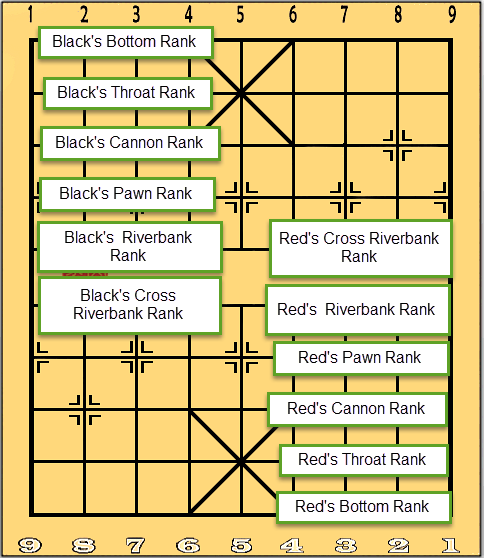Basics of Xiangqi (Chinese Chess) 03 The Chessboard
The Xiangqi Chessboard represents the battleground on which the game is played. This article would highlight more basic knowledge that is needed to know about the Xiangqi Chessboard than what has been covered in the previous article. It is very important to know some of the terms associated with the Xiangqi Chessboard as they would be needed for discussion.
The article would be presented based on the following topics:
- History of the Xiangqi Chessboard and its Symbolism
- Basic Terms
For the visitors who prefer watching videos, the Webmaster has also made a short video presentation that has been uploaded to Youtube, as shown below.
History of the Xiangqi Chessboard and its Symbolism
The ancient Chinese have long described Xiangqi as a game of miniature warfare, and the Xiangqi Chessboard would represent the battleground. The origins of the Xiangqi Chessboard cannot be ascertained, but many people believe that it represented a battleground that was located at Xingyang, He-nan Province, China. There was a canal called the Hong Gou. Click here for the link to Google Maps showing the place.
It was during the Chu-Han Contention (楚汉战争Chǔ Hàn Zhàn zhēng, 206-202 BC) where there was a standoff between Liu Bang (刘邦 Liú Bāng, c. 256 BC- 195 BC) and Xiang Yu (项羽 Xiàng Yǔ). Neither side could get the best of each other, and a treaty called the Treaty of the Hong Canal was signed. Later Liu Bang, the initial underdog, would manage to break the deadlock and defeat Xiang Yu, forcing Xiang Yu to commit suicide. Liu Bang would then establish the mighty Han Dynasty. But he would not have succeeded if he did not have help from able generals like Han Xin, Xiao He, and Zhang Liang. (1) (2) (3)
An interesting fact to know would be that Liu Bang was represented by the color Red and the color of Xiang Yu’s army was Black. There is much more symbolism that would be beyond the scope of this article.
An interesting fact is that in many Xiangqi boards, the Chinese characters 楚河汉界 (Chǔ hé Hàn jiè) can be found. The Chinese verse would refer to the standoff at Xingyang, as mentioned above.
There has been some controversy about the inscriptions of Chu-River and Han-Border on the Xiangqi board. Xiangqi ancient manual collector Liu Guobin stated that the inscriptions of Chu-River and Han-Border only appeared in the last century. (4 页 14)
However, there is a documentary that was done by CCTV in China, which discussed a Xiangqi board from 1108AD (大观二年). The inscription of 楚河汉界 could be seen clearly from the video. The video cannot be found on Youtube but it can be viewed at the following link .
There is another documentary which touches on the subject nicely. It has been embedded below.
Indeed, one of the hypotheses regarding the origins of Xiangqi was that it was invented during the Chu-Han Contentions. David Li believes that General Han Xin invented it based on his experience during the Chu-Han Contention. The origins of Xiangqi would be beyond the scope of this article. Still, for the sake of discussion with relation to the Xiangqi Chessboard, it would suffice to say that it probably had something to do with the Chu-Han Contention.
Basic Terms
Since the Xiangqi chessboard is the battleground, it would be important to know the ‘geography’ of the chessboard. The terms are crucial because they are used in Xiangqi notation, which has its own system and is completely different from the algebraic notation used in International Chess.
A Brief Description
The Xiangqi chess board is made up of nine vertical lines and ten horizontal lines. The pieces are played on the lines and not in the squares.
The vertical lines are called FILES, and the horizontal lines are called RANKS.
Files
There are different names to the files. The English names given below were based on a short glossary by the Asian Xiangqi Federation that was published decades ago. (5) (6)

|
File Number |
Chinese Name(s) |
English Translation |
|
1 & 9 |
边线 biān xiàn |
Edge File |
|
2 & 8 |
外肋 wài lèi |
External Rib File |
|
3 & 7 |
象位线 xiàng wèi xiàn |
Elbow File |
|
4 & 6 |
肋线 lè xiàn |
Rib File |
|
5 |
中线 zhōng xiàn |
Central File |
Ranks
Each rank would also have a unique name, as shown below.
|
Rank |
Chinese name |
English Translation |
|
1st rank (starting with rank where King is) |
底线 dǐ xiàn |
Bottom Rank |
|
2nd rank |
生命线 sheng mìng xiàn |
Throat Rank |
|
3rd rank |
炮位线 pàowèi xiàn |
Cannon Rank |
|
4th rank |
兵林线 bīng lín xiàn |
Pawn Rank |
|
5th rank |
河界线 hé jiè xiàn |
Riverbank Rank |
|
6th rank |
骑河线 qí hé xiàn |
Cross-riverbank Rank |
Note: Red’s Riverbank Rank would be the same rank as Black’s Cross-riverbank Rank.
For descriptive purposes, the Webmaster strongly recommends mentioning the color when describing the position of a piece. For example, it would be better to say “Red advanced his Cannon to Black’s Pawn Rank,” which would be a clear indication that the Cannon has crossed the River and was not advanced to his own Pawn Rank.
However, because the name is so established in Chinese literature, by default, certain moves or variations are so well-known that there is no need to mention the color. An example would be the Double Pawn Ranked Cannons Variation of the Screen Horse Defense.
The importance of knowing the names of the main files and ranks cannot be understated. Xiangqi can be discussed only when the people discussing know how to describe a piece that has moved or describe the important regions on the board.
River, Palace et cetera
There is a space in the middle that represents the RIVER, which separates the two opposing colors. The four corners of the chessboard are known as BOARDCORNERS.
There are unique squares that contain two diagonal lines in them. These two squares face each other across the River, and each square is known as the PALACE (九宮jiǔ gōng). Another Chinese name would be 九宫格 jiǔ gōng gé. The King and his two Advisors cannot leave their palace.
Many openings are named regarding the palace like the Cross-Palace Cannon Opening and the Palcorner Cannon Opening (see Glossary of terms). There are four PALACE CORNERS for each palace, which has been abbreviated as ‘PALCORNER.’ However, by default, ‘Palcorner’ would refer to one of the two palace corners ON THE CANNON RANK.
There are a few intersections that have extra markings on them. The markings are known as BOARDSTARS (盘星 pán xīng), and they help distinguish where the Pawns and Cannons are placed in the initial array. (5)
Additional verses
Some boards come with additional Chinese characters. Often there are Chinese characters in the middle ‘楚河汉界‘ as mentioned above.
Sometimes, additional Chinese verses are found on the side of the chessboard.
观棋不语真君子 (guān qí bù yǔ zhēn jūn zǐ) means that onlookers (观棋) should not comment(不语) on the game during active play and that such behavior is the mark of a true gentleman (真君子). Simply put, no kibitzing is allowed.
Another commonly seen verse would be 起手无悔大丈夫 (qǐ shǒu wú huǐ dà zhàng fu) which is translated as a man of his words (大丈夫) would make his moves without regret (无悔) and will not try to take back a move. Simply put, it would be a reminder that no take-back of the moves is allowed.
The Naming of the Files and Ranks
The files are numbered from RIGHT TO LEFT respective to the color. This concept is very important because one of the components of Xiangqi notation is the file number. Therefore, Red’s 1st file would be the same as Black’s 9th file, Red’s 2nd file be the same as Black’s 8th file, and so on.
HOW THE FILES ARE NUMBERED IS VERY IMPORTANT TO KNOW OR ELSE YOU WOULD HAVE TROUBLE READING OR WRITING THE NOTATIONS.
Please refer to the article on Xiangqi Notation for more.
References
1. Contention, Chu–Han. Chu–Han Contention. Wikipedia, The Free Encyclopedia. [Online] Aug 1, 2020. [Cited: Aug 28, 2020.] https://en.wikipedia.org/w/index.php?title=Chu%E2%80%93Han_Contention&oldid=970583654.
2. contributors, Wikipedia. Emperor Gaozu of Han. Wikipedia, The Free Encyclopedia. [Online] Aug 4, 2020. [Cited: Aug 28, 2020.] https://en.wikipedia.org/w/index.php?title=Emperor_Gaozu_of_Han&oldid=971093129.
3. —. Xiang Yu. Wikipedia, The Free Encyclopedia. [Online] 975023164, Aug 26, 2020. [Cited: Aug 28, 2020.] https://en.wikipedia.org/w/index.php?title=Xiang_Yu&oldid=975023164.
4. 张, 展. 象棋人生. 北京 : 经济管理出版社, 2012. 9787509621394 .
5. Png, Jim Hau Cheng. Lexicon of Xiangqi (Chinese Chess) Terms in English. Taipei : Jim Png Hau Cheng, 2017. 978-957-43-4707-0.
6. 王, 贵龙. 象棋名词术语手册. 呼和浩特 : 远方出版社, 2000. 7-80595-652-9.
7. 屠, 景明 and 杨, 柏伟. 象棋词典. 上海 : 上海文华出版社, 2009. 978-7-80740-339-5/G。475.
8. 刘, 殿中. 象棋新编课程 象棋初学门径. 北京 : 北京体育大学出版社, 2000. 7-81051-484-9.
9. 金海英. 象棋基础-我在北大讲课 Basics of Xiangqi, My Lectures at the Beijing University. 北京 : 人民體育出版社, 2006. 7-5009-2931-5/G.2830.
10. 王, 国栋, 方, 士庆 and 李, 燕贵. 跟我学象棋 初级教程. 成都 : 成都时代出版社, 2010. 978-7-80705-517-4.
11. 朱, 宝位. 棋牌入门丛书 象棋入门. 合肥 : s.n., 1994. 978-7-5337-0734-7.
